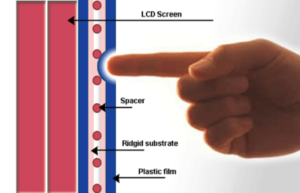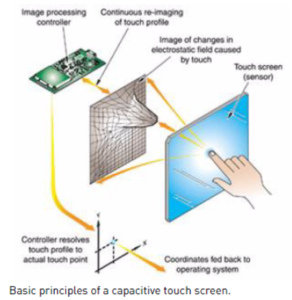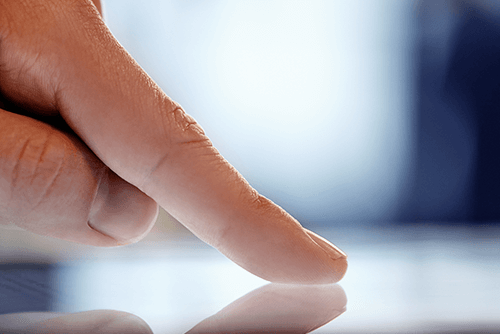Abstract
Touchscreens change the way we interact with computers and machines. They remove physical buttons, make computers and machines easier and more fun to interact with, and integrate more technology into our everyday lives. Touchscreens also allow us to humanize or anthropomorphize devices because it reduces the barrier between the user and the device. While this integration may be positive on its face, we must also consider the negative social impacts that come from treating devices as more human, communicative objects.
Introduction
It is always easier to control things with your own hands. Touching, tapping, swiping, are all hand gestures that are so easy a toddler could perform them. You probably would not see a two-year-old sitting next to a computer playing a game with a computer mouse and keyboard, but you might see a toddler playing the same game on a tablet or smartphone, happily tapping and swiping. Today young children can easily use computers thanks to the invention of touchscreens. Touchscreens remove some of the barriers between human and technology, making computers more portable and easier to use. Additionally, touchscreens have even more applications than those on computers; nowadays, touchscreens are everywhere, from our phones to the control panel on our refrigerators, and are an important part of our everyday lives.
History of touchscreens
There are two commonly used types of touchscreens: capacitive touchscreens and resistive touchscreens. E. A. Johnson invented the first finger-driven touchscreen in 1965 at the Royal Radar Establishment in Malvern, United Kingdom [1]. Johnson’s work is the foundation for the capacitive touchscreen, commonly used today in high-end smartphones and tablets. Five years later, Dr. G. Samuel Hurst, an American inventor, accidentally invented another type of touchscreens – the resistive touchscreen [1]. Originally, Hurst’s invention helped students research atomic physics, but later Hurst thought his invention could be used for something more: he and his team discovered that touchscreens could be used with a computer monitor. Hurst’s invention eventually became the foundation for resistive touchscreens, which we use widely today everywhere from supermarket registers to ATM machines.
How touchscreens work
The main idea behind the engineering of a touchscreen is that the display screen acts as both the input and output device for a machine. To achieve this, scientists and engineers use another transparent screen on top of the display screen. The composition of this transparent screen differs based on the type of touchscreen.
The resistive touchscreen consists of two layers. The first layer, on top of the screen, is a flexible transparent layer usually made of a transparent plastic called polyethylene, which is the main material in soda bottles. The second layer, which sits behind the flexible first layer, is rigid, usually made from glass. A metal compound that conducts electricity, most commonly transparent indium tin oxide, coats both of these layers, and tiny insulating dots, called spacers, keep the two layers apart. When the screen is on, it applies a small voltage across the screen in both horizontal and vertical directions [2]. When the user pushes his or her finger on the screen, the top layer is flexible so it will bend and touch the rigid layer, as shown in Figure 1. This will change the voltages across the screen. A processor connected to the screen will map out the screen as a grid and calculate the location where the finger pushed the screen in X and Y coordinates. Although this simple composition renders resistive touchscreens cheap to make, this dual-layer construction poses significant drawbacks: the touchscreen can only recognize the push of one finger at a time, and sometimes the screen requires a lot of force to register an input.


Benefits of touchscreens
In a machine, if there are a million things to control, then there must be a million buttons to control them. The touchscreens integrate these million buttons onto the screen itself. Instead of a computer with three components: a display screen telling you what is going on, a keyboard for you to type in telling the computer what to do, and a mouse for you to tell the computer which portion of the screen to look at, all you need is a computer with a touchscreen display. Touchscreens reduce the size of any computing machines; they integrate the machine’s outputs and human’s inputs as one onto the screen. Besides saving space, touchscreens also make it easy for humans to interact with computers. They humanize the computers, making them accessible at the fingertips and allowing many people to use computers. Kids can learn and play on tablets and smartphones without needing an adult to teach them how to use them. In fact, smartphones and tablets with touchscreens are so intuitive today that almost anyone can use them.
Another advantage touchscreens have is that they are very customizable as input devices. Unlike traditional physical buttons and computer peripherals, which require extra space to operate, touchscreens work smoothly with both software and hardware, letting the engineers put the virtual buttons or controllers anywhere on screen. One example is that users can easily change the size and shape of their keyboards on a touchscreen since they are not limited to the physical keyboard provided.
Downside of touchscreens
Although touchscreens allow engineers to bring many positive changes to the world, they also carry some negative social impacts to society. By making computers easy for everyone to use, people pay attention to the devices in their hands rather than their surroundings. Children are now playing more with their parents’ phones rather than playing outside – yet young children learn best from real world interactions [4]. Additionally, touchscreens reduce the size of a computer into a handheld-size smartphone, which makes it possible for people to do everything on their phone everywhere. Touchscreens remove some of the barriers between human and technology, but they improve upon the products that create a barrier between humans. It is important to find a balance so that we can enjoy the various benefits of these devices, while maintaining our connection to life around us.
Conclusion
The touchscreen is an important innovation that revolutionized the computer industry, making it possible for computers to become portable devices such as tablets and smartphones that everyone can use. Touchscreens make machines easier to use, from the ATM machine to the multimedia player on a car. They humanize machines, making the interaction between humans and machines as seamless as the touch of a finger. As great as they are, what might engineers and scientists do next to improve this technology? Maybe one day your touchscreen will touch you back! Maybe they could change texture depending on what is showing on the screen. Certainly, touchscreens of the future will continue to make computers and other machines even more entertaining and easier to use.
References
[1]F. Ion (2013, April) “From touch displays to the Surface: A brief history of touchscreen technology” [online]. Available: http://arstechnica.com/gadgets/2013/04/from-touch-displays-to-the-surface-a-brief-history-of-touchscreen-technology/
[2] SciShow (2016, May) “How do touchscreens work?” [online]. Available: https://www.youtube.com/watch?v=wKuqNuzM1oM
[3] M. Agrawal (2010, March). “Difference between Capacitive and Resistive Touchscreens” [online]. Available: http://www.telecomcircle.com/2010/03/touchscreen/
[4] L. L. Brown (2016, Jan). “When to Introduce Your Child to a Smartphone or Tablet” [online] . Available: http://www.pbs.org/parents/childrenandmedia/article-when-introduce-child-smartphone-tablet.html
[5] A. Cockburn, D. Ahlström and C. Gutwin. Understanding performance in touch selections: Tap, drag and radial pointing drag with finger, stylus and mouse. International Journal of Human-Computer Studies 70(3), pp. 218-233. 2012. . DOI: 10.1016/j.ijhcs.2011.11.002.




